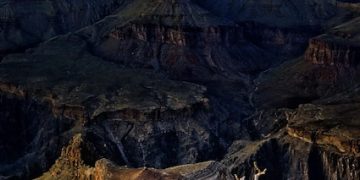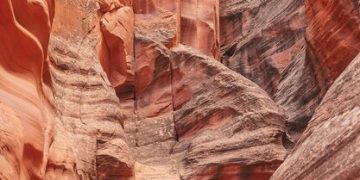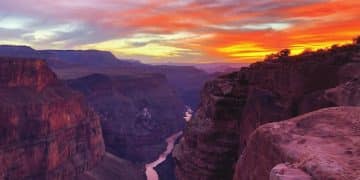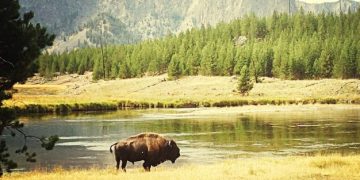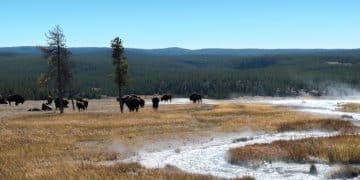7-Day US Dark Sky Parks Itinerary: Stargazing Adventures
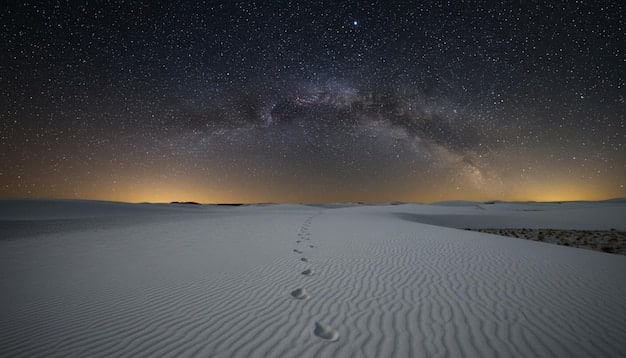
Embark on a 7-day stargazing and astrophotography adventure through the US Dark Sky Parks, exploring celestial wonders in areas with minimal light pollution, perfect for observing the night sky’s beauty.
Are you ready to explore the cosmos and capture breathtaking images of the night sky? Our 7-Day US Dark Sky Parks Itinerary: Stargazing and Astrophotography Adventures will guide you through some of the most stunning locations in the United States where you can witness the beauty of the universe.
Planning Your Dark Sky Adventure
Planning a trip to dark sky parks can be an incredible experience, but some preparation is necessary to make the most of it. Below are a few key considerations to ensure your adventure is memorable and successful.
Best Time to Visit
The best time to visit dark sky parks is during the new moon phase when the night sky is at its darkest. Also, consider the time of year; summer months often offer warmer temperatures, but winter months can provide clearer skies due to less humidity.
What to Pack
Packing appropriately can significantly enhance your stargazing experience. Essential items include warm clothing (even in summer, nights can be cold), a red light flashlight (to preserve your night vision), binoculars, a telescope (if you have one), and camera equipment for astrophotography.
- Warm Layers: Temperatures can drop significantly at night.
- Red Light Flashlight: Preserves night vision.
- Binoculars: Enhances viewing of constellations and celestial objects.
- Camera Gear: Tripod, camera, and lenses for astrophotography.
Remember to check the weather forecast before you go and pack accordingly, ensuring you’re prepared for any conditions you might encounter during your dark sky adventure.
Proper planning ensures a fantastic stargazing experience. Choosing the right time, packing the right gear, and knowing what to expect will prepare you to be amazed by the celestial wonders awaiting you.
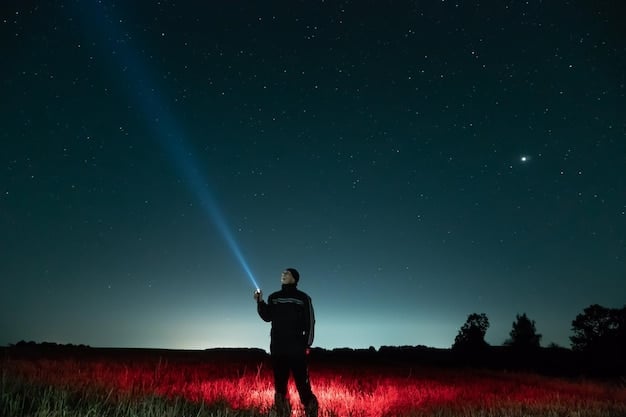
Day 1: Arrival in Flagstaff, Arizona and Lowell Observatory
Begin your dark sky journey in Flagstaff, Arizona. Known for its commitment to preserving dark skies, Flagstaff is a perfect starting point for any astronomy enthusiast. Here’s how to spend your first day.
Exploring Lowell Observatory
Start your adventure at Lowell Observatory, one of the oldest observatories in the United States. It’s where Pluto was discovered in 1930. Take a guided tour to learn about the observatory’s history and its contributions to astronomy.
Evening Stargazing Program
In the evening, participate in a stargazing program at Lowell Observatory. Knowledgeable guides will point out constellations, planets, and other celestial objects using powerful telescopes. It’s an excellent way to begin your dark sky experience.
- Guided Tours: Learn about the history and discoveries of Lowell Observatory.
- Stargazing Programs: Observe celestial objects through high-powered telescopes.
- Exhibits: Explore interactive exhibits on astronomy and space exploration.
Flagstaff provides a fantastic beginning to your dark sky park adventure, offering both educational and breathtaking celestial viewing opportunities.
Lowell Observatory offers an amazing start to your dark sky itinerary, with interesting historical insights and great stargazing experiences.
Day 2 & 3: Grand Canyon National Park Stargazing
On days two and three, journey to the Grand Canyon National Park. The park is an International Dark Sky Park and offers spectacular views of the night sky against the backdrop of one of the world’s most iconic landscapes.
Finding Stargazing Spots
Mather Point and Yavapai Geology Museum offer accessible viewpoints with expansive sky views. For a more secluded experience, consider hiking a short distance along the South Rim Trail away from the main crowds.
Nighttime Activities
Participate in ranger-led astronomy programs to learn about constellations and celestial phenomena. You can also set up your telescope or camera to capture the Milky Way stretching over the Grand Canyon.
The Grand Canyon offers unparalleled views of the night sky in a dramatic setting. Whether you’re using binoculars or just your eyes, the experience is well worth the visit.

Day 4: Driving to Death Valley National Park
On day four, drive from the Grand Canyon to Death Valley National Park. This journey takes approximately 5-6 hours, so start early to maximize your time in Death Valley. Be sure to stock up on water and supplies before you leave, as facilities are limited within the park.
Scenic Route
Enjoy the scenic drive through the Mojave Desert. As you approach Death Valley, the landscape will transform into vast, starkly beautiful terrain. Stop at viewpoints along the way to capture the unique desert scenery.
Settling In
Once you arrive in Death Valley, check into your accommodations. Options range from camping sites to lodge rooms. After settling in, take some time to explore the local area and prepare for an evening of stargazing.
The drive to Death Valley is more than just a means to an end; it’s an integral part of your journey, offering stunning desert landscapes and a sense of anticipation for the dark skies ahead.
The drive from the Grand Canyon to Death Valley is a long one, but it is well worth it for the stunning night skies that await you. The changing landscapes along the way make for a truly unique travel experience.
Day 5 & 6: Stargazing in Death Valley National Park
Death Valley National Park, another International Dark Sky Park, is one of the best places in the world for stargazing. With minimal light pollution and clear desert skies, it offers unparalleled views of the cosmos.
Prime Stargazing Locations
Popular spots include Badwater Basin, Zabriskie Point, and Mesquite Flat Sand Dunes. Each location provides a unique backdrop for astrophotography and stargazing. Badwater Basin, the lowest point in North America, offers a surreal landscape for viewing the night sky.
Astrophotography Tips
For capturing stunning photos of the night sky, use a tripod and a camera with manual settings. Experiment with long exposures to capture the faint light of distant stars and galaxies. Consider using a wide-angle lens to capture the vastness of the Milky Way.
- Badwater Basin: Surreal landscape for viewing the stars.
- Zabriskie Point: Offers panoramic views of the night sky.
- Mesquite Flat Sand Dunes: Provides a unique foreground for astrophotography.
Death Valley’s dark skies provide a canvas for unforgettable memories, whether you’re capturing images or simply reflecting on the wonders of the universe.
Death Valley’s dark skies and otherworldly landscapes make it a fantastic opportunity to explore and capture the night sky.
Day 7: Departure from Las Vegas or Return
On your final day, drive from Death Valley to Las Vegas (approximately 2 hours) for your departure. Alternatively, if you’re driving back, use this day to start your journey home, reflecting on the incredible sights you’ve witnessed.
Last Reflections
Take some time to review your photos and journal about your experiences. Consider which dark sky parks you enjoyed the most and plan future trips to other dark sky destinations.
Extending Your Stay
If time allows, spend an extra day in Las Vegas to enjoy the city’s attractions or relax before traveling home. You can visit the Hoover Dam, explore the Strip, or enjoy a world-class show.
As your dark sky adventure concludes, the memories and images you’ve captured will stay with you long after you’ve returned home, inspiring future explorations of the night sky.
Whether departing from Las Vegas or heading home, the memories of a 7-day dark sky adventure will last a lifetime.
| Key Point | Brief Description |
|---|---|
| 🔭 Dark Sky Parks | Locations with minimal light pollution, ideal for stargazing and astrophotography. |
| 🌃 Grand Canyon | Offers expansive sky views and ranger-led astronomy programs. |
| 🏜️ Death Valley | Known for its minimal light pollution and clear desert skies. |
| 📸 Astrophotography | Use a tripod, manual settings, and long exposures to capture the night sky. |
FAQ
▼
A Dark Sky Park is an area recognized for its exceptional quality of starry nights and nocturnal environment that is specifically protected for scientific, natural, or educational purposes.
▼
Essential gear includes a sturdy tripod, a camera with manual settings, a wide-angle lens, and potentially a remote shutter release to avoid camera shake during long exposures.
▼
The best time to visit is during the new moon phase, when the sky is darkest, and on clear nights with minimal cloud cover. Check the local weather forecast before you go.
▼
Yes, many dark sky parks offer guided astronomy programs, ranger talks, and stargazing events. Check the park’s website for schedules and reservations.
▼
Dress in warm layers, even in summer, as temperatures can drop significantly at night. Also, wear comfortable shoes suitable for walking in the dark.
Conclusion
Embarking on a 7-day journey through the US Dark Sky Parks offers an unforgettable experience for stargazing and astrophotography enthusiasts. From the historic Lowell Observatory to the vast landscapes of the Grand Canyon and the surreal terrains of Death Valley, each location provides unique opportunities to witness the beauty of the cosmos and capture stunning images of the night sky, creating memories that will last a lifetime.
